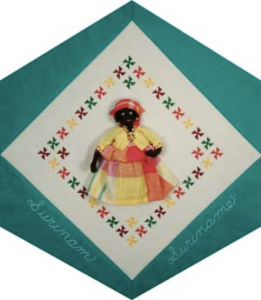Suriname

The Block
Blockmaker Joyce Ford was inspired by childhood memories growing up on a sugar plantation in Suriname. Within a frame of colourfully embroidered windmills rests the dominant element of this block; a miniature doll dressed in a traditional koto. The koto, a heavy and bulky costume stuffed with straw, was once worn by women slaves in Suriname. There are two versions as to how the dress came about. One claims it was designed by the wives of plantation owners to prevent their husbands from being attracted to the women. The other says it was the slaves themselves who developed it to hide their figures from their masters.
Made with bright madras or floral fabrics, the koto is worn with a short cape and matching anjisa, a unique headdress. The anjisa eventually became a means of communication between male and female slaves who were not permitted to meet. Women would tie them in various styles to signify a message or personal statement. The koto is still worn in Suriname for special occasions but it has now been modernized and transformed into a celebration of perseverance and freedom.
Cultural Profile
Suriname, sometimes spelled Surinam, is located on the northeast coast of South America. Named after the Surinen Indians, the earliest inhabitants, it is the smallest independent country on the continent with almost 400 kilometres of coastline, the western section of which contains canals reminiscent of The Netherlands. Suriname, formerly known as Dutch Guiana, maintains close ties with The Netherlands, which obtained the territory from England in exchange for the island of Manhattan.
Plantation agriculture was once the backbone of the Suriname economy; however, the mining of gold and bauxite (an aluminium ore) is currently the greatest national income generator. With most of its population concentrated on the coast, Suriname is home to a mountainous interior covered with lush tropical forests harbouring tropical hardwood trees and exotic birds. It is home to the Surinam Toad, also known as the ‘Pipa Pipa’, the world’s flattest frog. This unique species is best known for its breeding habits in which eggs are embedded into the skin of the female’s back, forming pockets in which the young develop.
Suriname has a small but diverse population representing ethnic groups from several continents. The major groups are East Indians, descended from indentured labourers brought by the British, and Creoles, with sizable communities of Indonesians, Maroons, Amerindians, Chinese and Europeans. Dutch is the official language, although most people also speak Sranan, a local language that includes elements of several other languages. Additional languages include English, Sarnami, Javanese, Chinese, Hindi and a number of Amerindian languages. A testament to the country’s diversity, national holidays include Chinese New Year, the Hindu festival of Holi, Easter, and the Dutch Saint Nicholas, on December 6th.
Suriname’s diverse culture is a mixture of Western, African and Asian influences, although each ethnic group strives to hold on to its own heritage. Sculptures and intricate wood-carvings express values of the East Indian and Maroon population, while gamelan, Indonesian music, provides insight into the Indonesian community’s cultural life. The country is also known for its distinctive earthenware, wayang, an Indonesian puppetry tradition, dances in which elaborate costumes are worn, Indian basket ware, Creole embroidered tablecloths, and batik fabrics.
Surinamers have been coming to Canada for many years. Their numbers however, remain small (the 2001 census reports less than 1,000 currently in this country) and significant Surinamese communities have yet to be established.
